
Stachys palustris · pelkinė notra
- marsh woundwort, clown's woundwort, clown's heal-all, marsh hedgenettle, hedge-nettle
- Sumpf-Ziest, Schweinerübe
- pelkinė notra
- purva sārmene
- czyściec błotny
It is native to parts of Eurasia but has been introduced to North America. Its typical habitat is near the shore of lakes, in marshes with alder trees, on the banks of ditches and streams, in damp meadows, in arable ground and in waste places. In arable land, it is a difficult weed to get rid of because of its persistent tubers.
Lietuviška wikipedia sako, kad nuodinga, bet šakniagumbiai valgomi. Palaipų gumbeliai trapūs, jais augalas lengvai dauginasi ir plinta. Šiuos gumbelius galima virti ir valgyti kaip daržovę. Sėklų aliejus tinka geros kokybės pokosto gamybai. Antžeminė augalo dalis dažo audinius žalia spalva. Žiedai turi nektaro, lankomi vabzdžių. Augalas nuodingas. Auga daržuose, laukuose, krūmuose ir pakrūmėse, kirtimuose, dykvietėse, paprastai apydrėgniuose ir drėgnuose dirvožemiuose. Lietuvoje dažna.
‥- model
- Canon EOS 6D
- f
- 4
- EV±
- 0.0 EV
- speed
- 1/200 s
- flash
- no, mode: supressed
- ISO
- 100
- focal
- 100 mm
- mode
- auto
0 comments
Add a comment
Comments